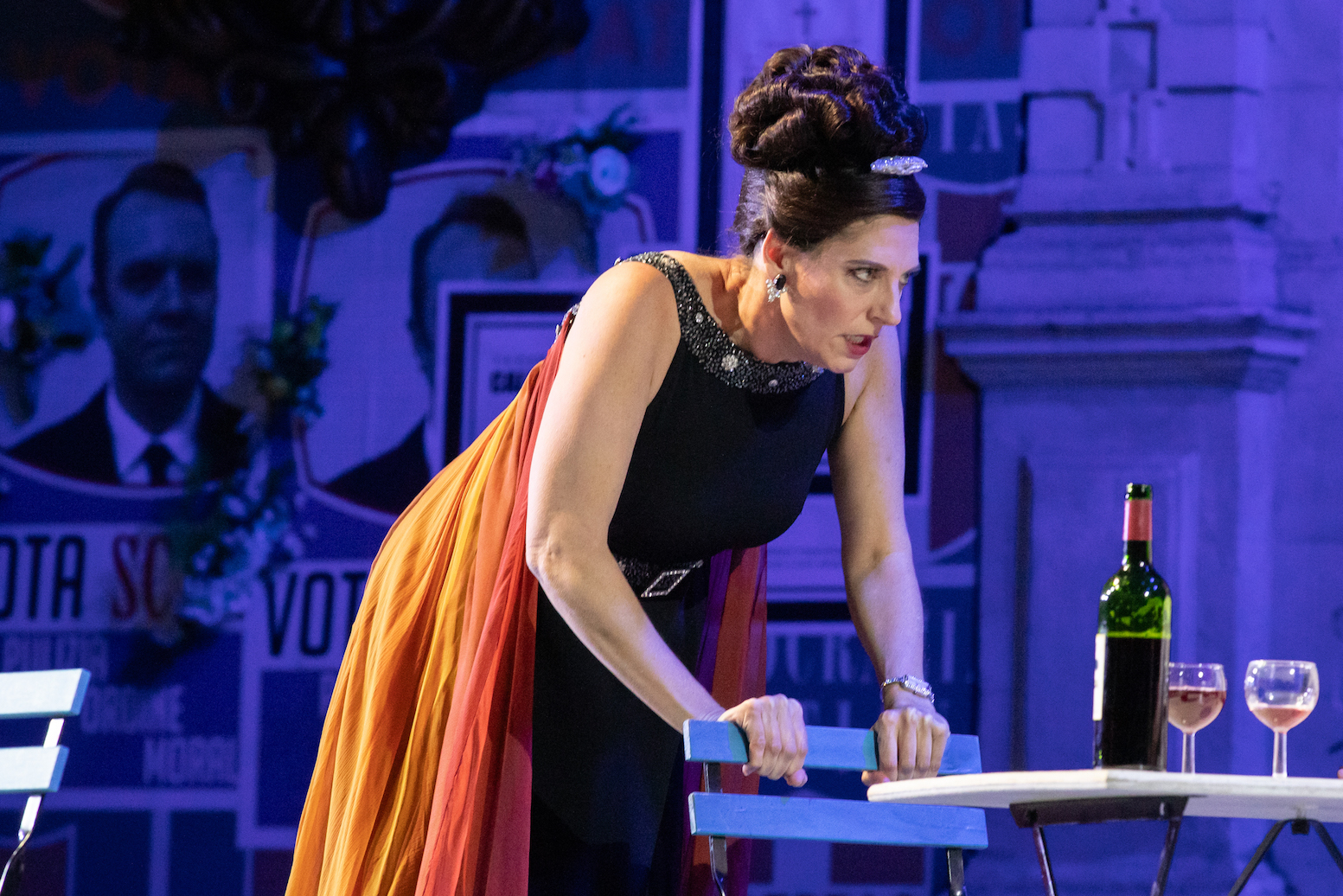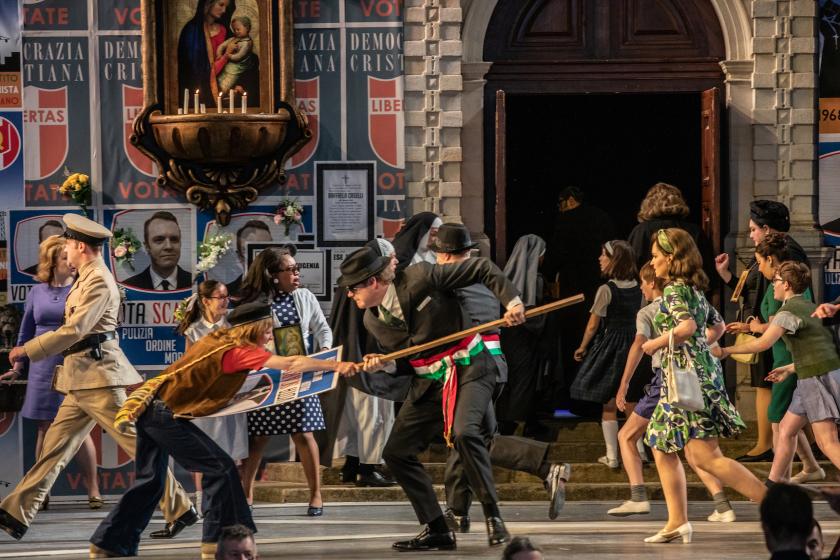Set in a tensely polarised Roman neighbourhood, with an election in the offing and radicals scrapping with reactionaries under poster-plastered walls, Stephen Barlow’s smart update of Tosca from 1800 to 1968 might have felt like a double dose of period-piece on its first outing at Opera Holland Park in 2008. Strongly cast and crisply delivered, this polished and gripping revival gives us Puccini the prophet as well as the pot-boiler.
Unctuous and bullying by turns, Morgan Pearse’s Scarpia is a sharp-suited populist schemer whose election posters – stuck across the walls of Yannis Thavoris’s finely detailed set – proclaim him (in Italian) the champion of “Cleanliness, Order, Morality”. The feverish political climate on stage here, which accommodates the libretto’s 1800-era references to Napoleonic battles, cannons and carriages without missing too many beats, recalls not just the Rome but the London of today. You half-expect Scarpia to sing of his promise to stop the boats.  Opera Holland Park may have opened its 2024 account with a safely popular (if not populist) choice. But this revival amply showcases the company’s sturdy bones and acute senses. Amanda Echalaz, who began her international Tosca journey here in 2008, now brings a proud, bruised maturity – both imperious and thin-skinned – to the diva’s fate (pictured above). As street-artist Cavaradossi – here, a kind of pious hippie-era Banksy – José de Eça rises to the challenge of the set-piece arias with an authentic spinto warmth and bite (pictured below with Echalaz). Arguably, Pearse tops both in his serpentine twists of charm and cruelty: you can easily imagine him milking applause on Question Time before slinking off to rape and torture.
Opera Holland Park may have opened its 2024 account with a safely popular (if not populist) choice. But this revival amply showcases the company’s sturdy bones and acute senses. Amanda Echalaz, who began her international Tosca journey here in 2008, now brings a proud, bruised maturity – both imperious and thin-skinned – to the diva’s fate (pictured above). As street-artist Cavaradossi – here, a kind of pious hippie-era Banksy – José de Eça rises to the challenge of the set-piece arias with an authentic spinto warmth and bite (pictured below with Echalaz). Arguably, Pearse tops both in his serpentine twists of charm and cruelty: you can easily imagine him milking applause on Question Time before slinking off to rape and torture.
Little about the Fellini-style street scenes grate except, perhaps, a fussy over-dependence on the on-stage Fiat 500 that first shelters the radical runaway Angelotti (Edwin Kaye) and will later play a decisive part in the climax. (Don’t expect any leap from the battlements in this Rome of cigarettes and carburettors.) The Farnese palace where Scarpia tortures Cavaradossi becomes a neon-signed café, run by Alex Jones’s Sciarrone; a bolt-hole for this sinister capo to seal his deals. Barlow and Thavoris make clever use of the stage’s broad expanses and evocative stonework: these run-down Roman palazzi, after all, are the actual remnants of a Jacobean great house. As so often, conductor Matthew Kofi Waldren and OHP’s house band – the City of London Sinfonia – sturdily seized the opportunity of their place right at the centre of the action. They delivered not just background music but the densely coloured Roman scene-painting – chiming, blending bells and all – that peaks in Puccini’s extraordinary, and beautifully executed, prelude to Act III. Cellos, horns, clarinets and harp painted the city in tender shades while Waldren wrung every drop of drama from the Wagner-meets-Hollywood motifs that define character and mood. The big ensemble scenes stirred, above all the mingling of the first act Te Deum with a clash between a political demo and a sacred procession. Throughout, the chorus – of adults and children alike – enjoyed stand-out moments of both grace and gusto.
As so often, conductor Matthew Kofi Waldren and OHP’s house band – the City of London Sinfonia – sturdily seized the opportunity of their place right at the centre of the action. They delivered not just background music but the densely coloured Roman scene-painting – chiming, blending bells and all – that peaks in Puccini’s extraordinary, and beautifully executed, prelude to Act III. Cellos, horns, clarinets and harp painted the city in tender shades while Waldren wrung every drop of drama from the Wagner-meets-Hollywood motifs that define character and mood. The big ensemble scenes stirred, above all the mingling of the first act Te Deum with a clash between a political demo and a sacred procession. Throughout, the chorus – of adults and children alike – enjoyed stand-out moments of both grace and gusto.
In general, Barlow’s vision yields a Tosca marked by dramatic pace and focus rather than especially memorable vocal summits. The production flows and veers and shocks as it should as Scarpia’s consuming lust, for Tosca herself and above all for power, drags the diva and her artist-lover to their doom. Rich and rounded in her tone, Echalaz moves convincingly from the Sophia Loren-like designer-label glamour of the first act to the incendiary tigress of the second with a corresponding gain in heft and lustre. However, this fine-grained theatrical momentum makes the breaking of the fourth wall for “Vissi d’arte” – when she comes to the front to appeal directly to the audience – feel like a stylistic clash. That said, she achieved a sobbing, cracking pathos allied to radiant authority across her register.  Every stab at Tosca has to balance realism and ritualism. Barlow’s savoury period detail and fluid movement lent coherence and energy to the show but made the leaps into a more formal “operatic” mode (as with de Eça’s silkily sung “Recondita harmonia”) oddly more jarring than they would be in a stiffer and statelier production. Not that any listener would have wanted the impassioned control of his “E lucevan le stelle” brought down a single notch. Tosca’s ceremonial dumb-show after she slays Scarpia maybe had a touch of bathos (she ends by pulling down the café shutters) – though the memory of Callas’s peerless corpse-arrangement (in Zeffirelli’s version) will always be hard to banish. Still, the preceding dialogue between predator and prey (though which is which?) had simmered and flared at a properly electric heat, with Pearse a most commanding creep (pictured above).
Every stab at Tosca has to balance realism and ritualism. Barlow’s savoury period detail and fluid movement lent coherence and energy to the show but made the leaps into a more formal “operatic” mode (as with de Eça’s silkily sung “Recondita harmonia”) oddly more jarring than they would be in a stiffer and statelier production. Not that any listener would have wanted the impassioned control of his “E lucevan le stelle” brought down a single notch. Tosca’s ceremonial dumb-show after she slays Scarpia maybe had a touch of bathos (she ends by pulling down the café shutters) – though the memory of Callas’s peerless corpse-arrangement (in Zeffirelli’s version) will always be hard to banish. Still, the preceding dialogue between predator and prey (though which is which?) had simmered and flared at a properly electric heat, with Pearse a most commanding creep (pictured above).
The Sacristan from Holland Park stalwart Ross Ramgobin provided relaxed charm without heavy-footed clowning, while young Angelo Aninag delighted with the shepherd boy’s song. The contrast between wide-angled action behind the orchestra and close-up solos and duets in front highlighted not just but the 19th-century theatrical but the 20th-century cinematic flair of Puccini’s stagecraft. Despite its late-Sixties imagery (and fashions) Barlow’s Tosca still feels urgently modern, disarmingly close to us in feeling and in form. It deserves to match, or even trump, its original success.















Add comment